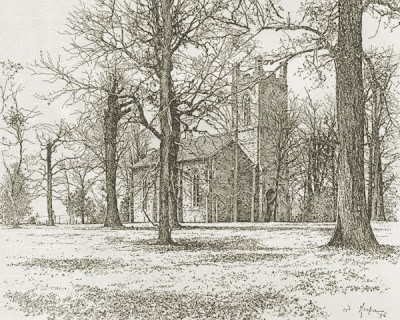(Unused - divided back, c1940s)
In 1864, the Confederate Army of Tennessee marched past St. John's Episcopal Church on its way to face Union troops at nearby Franklin, Tennessee. General Patrick Cleburne, while passing by the church, is said to have remarked, "This is the most beautiful and peaceful spot I ever beheld . . . It is almost worth dying to be buried in such a beautiful spot." Several days later Cleburne, General H. B. Granbury, and General O. F. Strahl died at the Battle of Franklin and were buried at St. John's.
Located in an area known as Ashwood between the towns of Columbia and Mt. Pleasant in Middle Tennessee, St. John's Church is one of Maury County's most treasured historical sites. Built by Leonidas Polk and his three brothers: Rufus, Lucius, and George – cousins to President James K. Polk – the church is located at a point where the brother's plantations came together. The land and material for the church was donated by the brothers and built by slaves. The pulpit, reredos, and altar rail were made from a single wild cherry tree that grew on the site. It was a plantation church meant to provide a place of worship for the Polk families, their slaves, and their neighbors.
Construction began in 1839 and completed three years later. Bishop James Hervey Otey, the first Episcopal Bishop of Tennessee, consecrated the church on Sept. 4, 1842. Leonidas Polk served as St. John's first rector and would later become the first Bishop of Louisiana and a general in the Confederate Army know as the 'Fighting Bishop'.
Behind St. John's is the traditional churchyard burial ground where generals Cleburne, Granbury, and Strahl were buried. Years later their remains were removed and re-buried in other states, but their gravesites at St. John's have never again been used. All but one of the Polk brothers would eventually be buried at St. John's. Resting at St. John's are members of the Polk family, Civil War soldiers, and five Episcopal bishops including Bishop Otey.
St. John's continued regular services until 1915 when the congregation dwindled to just one family. Since 1921, services are held only once a year on Whitsunday – the Feast of Pentecost. The service always draws a large crowd and afterward a picnic is held on the grounds.
St. John's remains today much as it was during the 1800's. There is no electricity and no running water. It still has the original furnishings, hand-blown leaded glass windows, and the 1890 Packard reed pump organ. Also, the original silver chalice used by the Polk family is once again used for the Whitsunday service.
For 160 years, St. John's kept a peaceful existence that not even the Civil War could betray. But the peace and serenity at St. John's came to an end when two present day teenagers broke into the church and vandalized it in May 2001. The tragedy occurred just one week before the annual pilgrimage to St. John's to celebrate Whitsunday.
The church windows were broken out, the Baptismal font was damaged, and the organ that sat in the choir loft was thrown to the sanctuary floor below. Tombstones in the graveyard were toppled or destroyed. Two young men were later arrested and charged with the destruction.
After news of the vandalism spread, the community – regardless of denomination – turned out to help cleanup the church and make temporary repairs so that its annual service could be held. Donations came from people near and far sympathetic to the tragedy the church had suffered. The anger and grief over what happened, as well as the show of support, demonstrate the affection for the historic church.
Mary Polk Branch described St. John's Church in 1911 with these words, "This church of many memories stands in a cemetery of seven or eight acres surrounded by a stone wall. The large oak trees and the carpet of blue grass make it a lovely spot, but the doors of the church are closed, the windows unopened, the iron-gate in front locked. . . . In the distance is heard the sound of the automobile and the roll of heavy wagons upon the pike, and we realize the brightness of the world without and the busy life which surrounds the old church with its story of the past."
— Dan Hardison

For photographs of St. John's as it appears today, visit Windscape studio at flickr.com.






